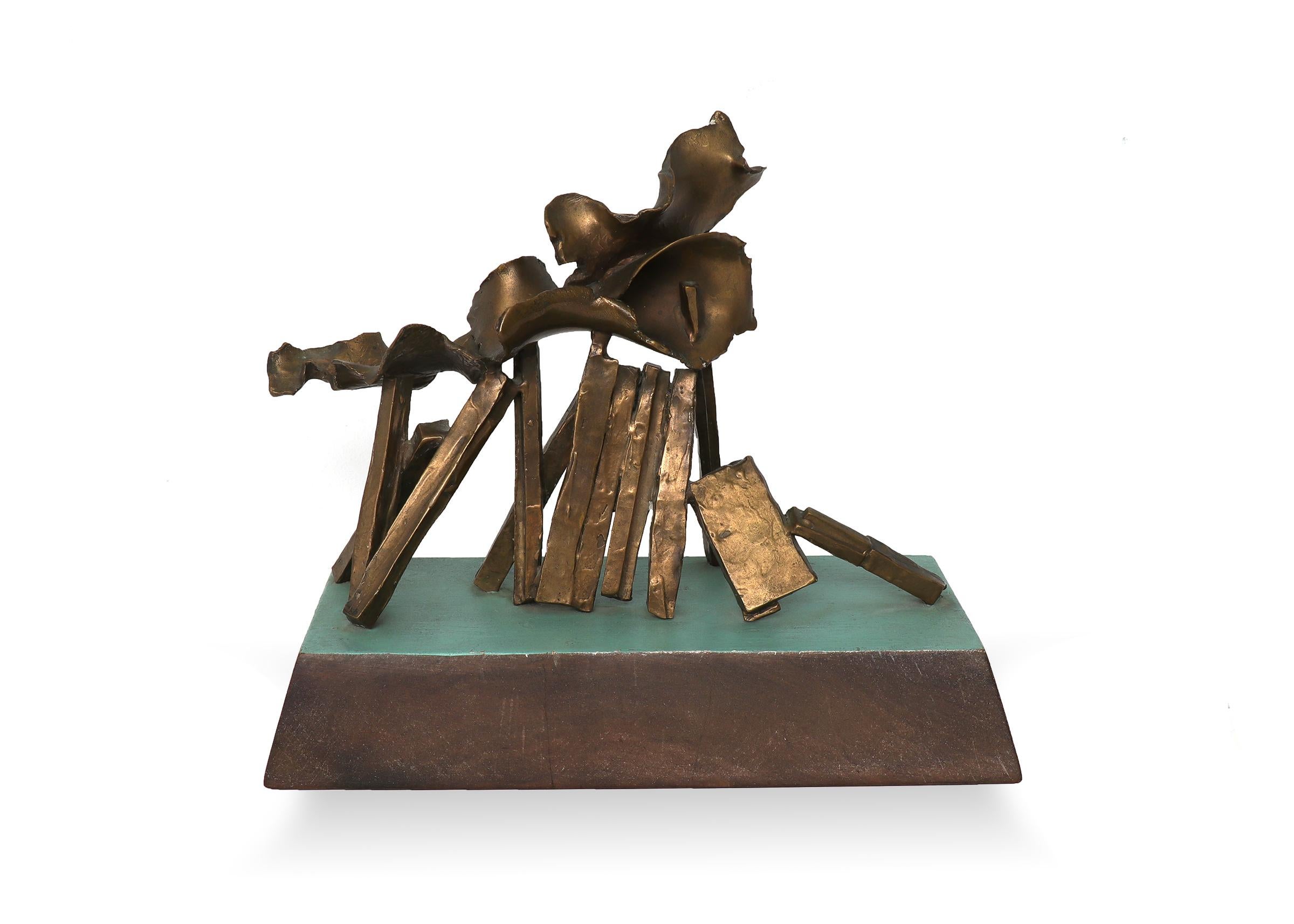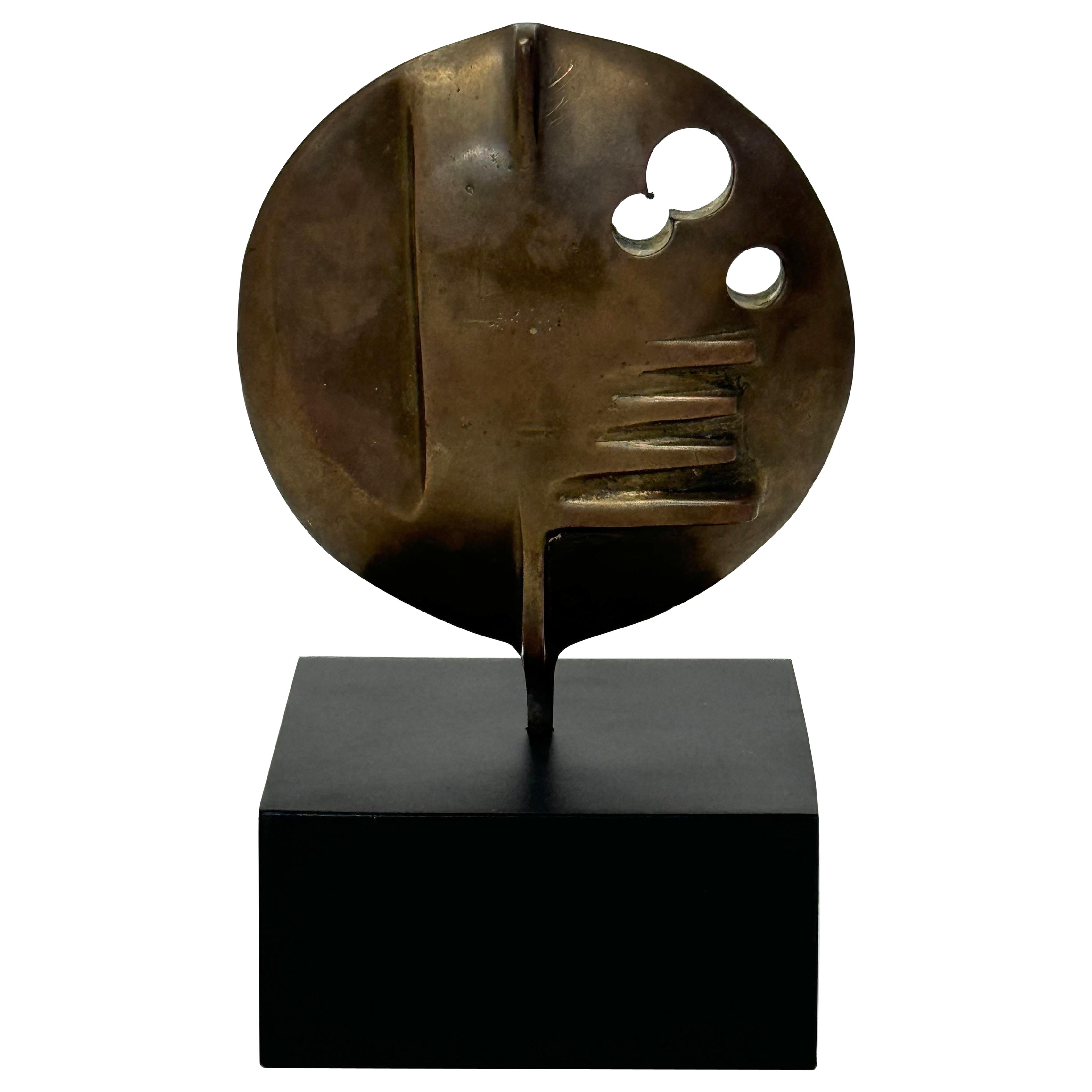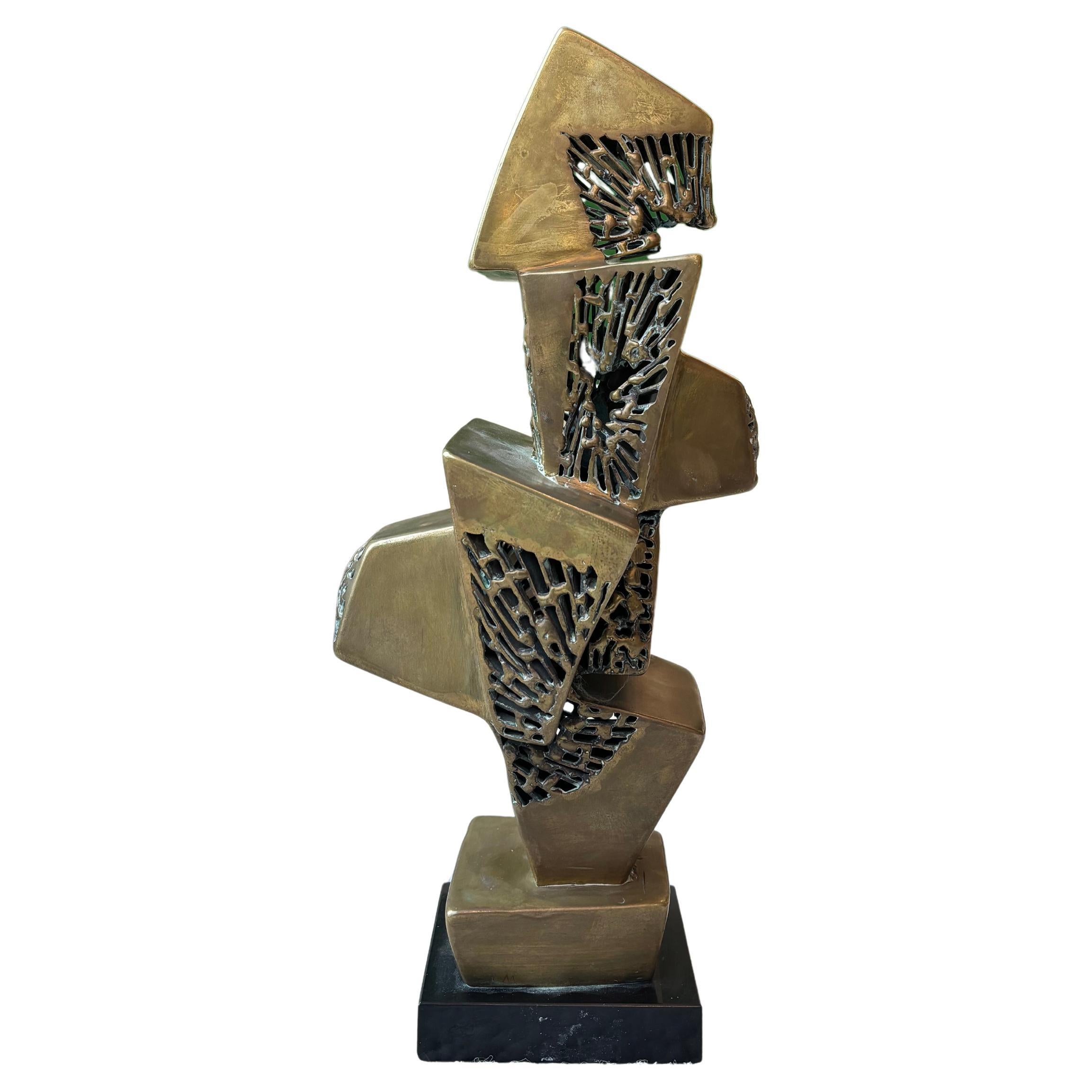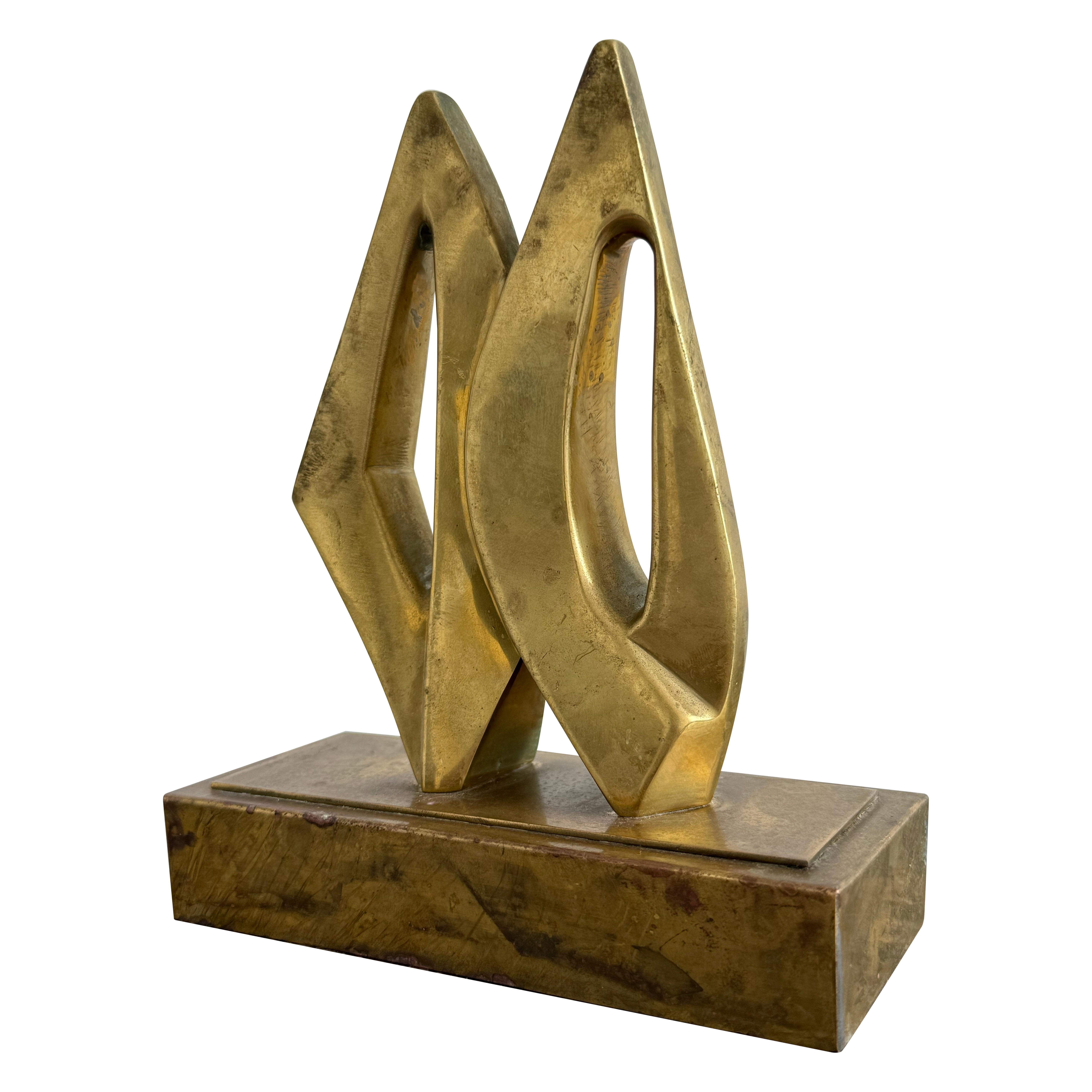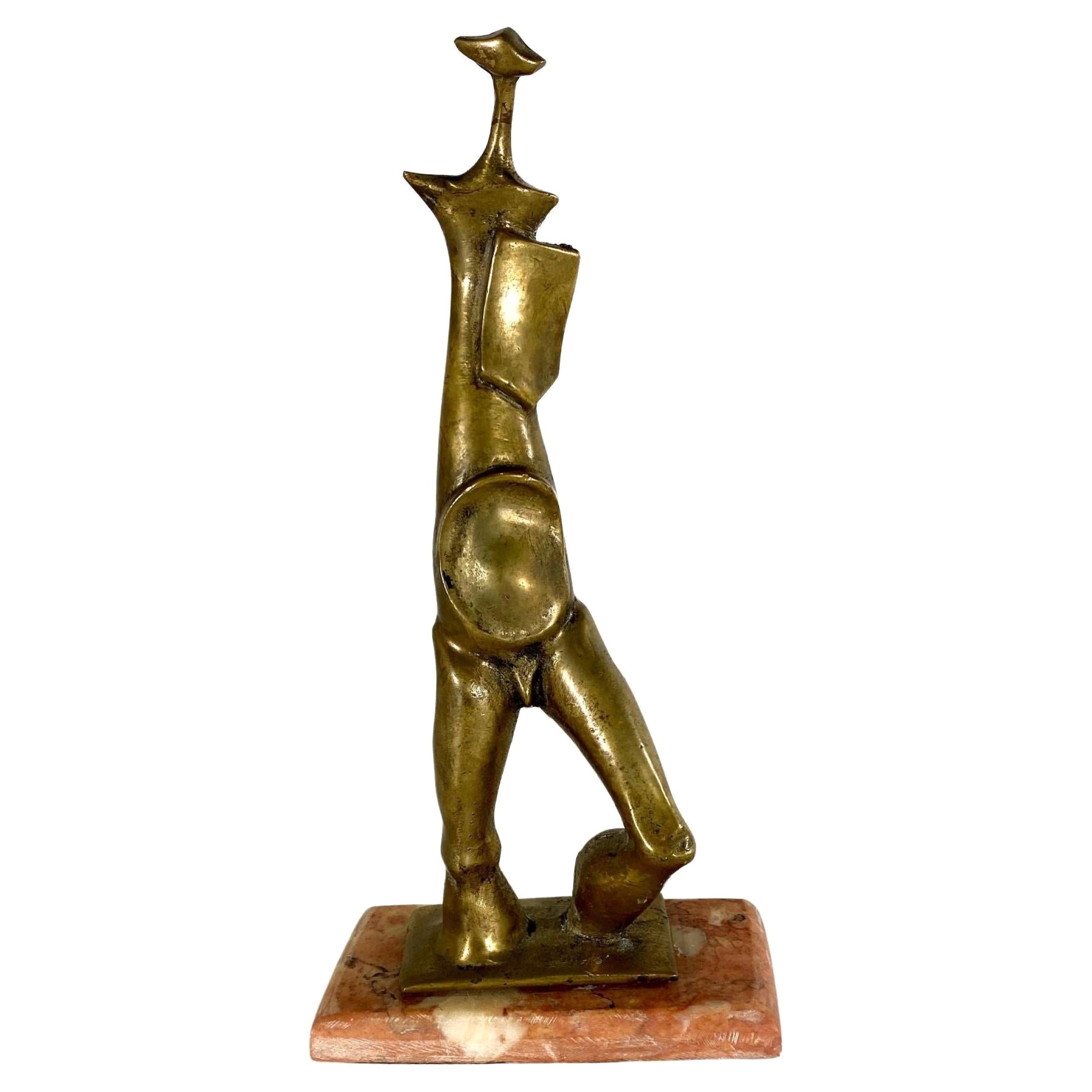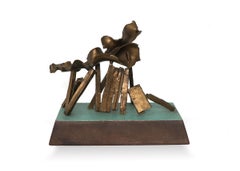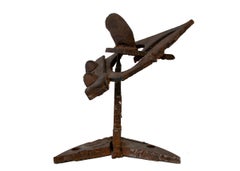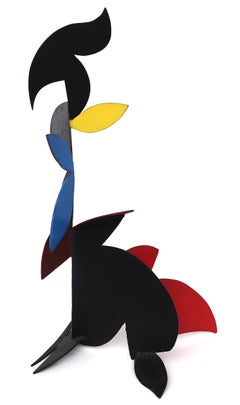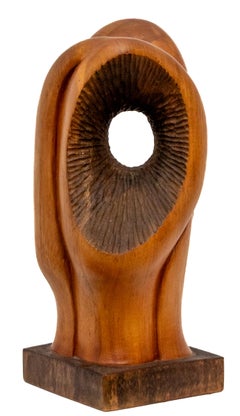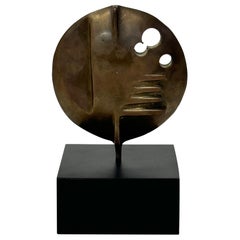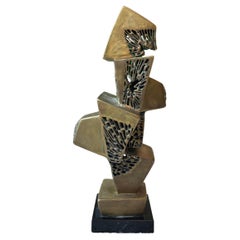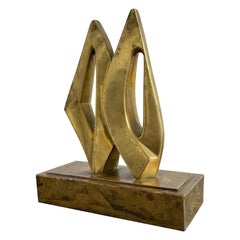Items Similar to Mid Century Modern Abstract Bronze Sculpture on Granite Stand by Edward Chavez
Video Loading
Want more images or videos?
Request additional images or videos from the seller
1 of 15
Edward Arcenio ChavezMid Century Modern Abstract Bronze Sculpture on Granite Stand by Edward Chavez
$4,250
£3,194.88
€3,703.88
CA$5,933.66
A$6,646.01
CHF 3,458.14
MX$80,715.38
NOK 43,840.46
SEK 41,366.74
DKK 27,636.19
Shipping
Retrieving quote...The 1stDibs Promise:
Authenticity Guarantee,
Money-Back Guarantee,
24-Hour Cancellation
About the Item
This striking modern abstract bronze sculpture by Edward (Eduardo) Arcenio Chavez (1917-1995) is mounted on a polished granite base. The piece measures 7 ½ x 6 x 2 inches, including the stand, and features Chavez's signature fluid, organic forms and intricate textures that reflect his mastery in both bronze casting and sculptural design. It is in very good to excellent condition. Please contact us for a detailed condition report.
About the Artist:
Edward Chavez, born in Wagonmound, New Mexico, in 1917, was a highly regarded American artist known for his works as an illustrator, muralist, painter, sculptor, and lithographer. He was influenced by prominent instructors at the Colorado Springs Fine Arts Center, including Boardman Robinson, Frank Mechau, Arnold Blanch, and Peppino Mangravite. Chavez's early murals in the western United States gained him recognition before his service in World War II.
After WWII, Chavez settled in Woodstock, New York, where he became part of the vibrant post-war arts scene. Woodstock attracted numerous artists from across the country, fostering an inspiring environment for Chavez and his wife, artist Jenne Magafan. There, he joined a community that included artists like Bruce Currie, Fletcher Martin, and Mitchell Siporin. During this time, Chavez made lasting contributions to the arts, garnering prestigious awards such as the Tiffany Grant (1948), the Fulbright Award (1951), and the Childe Hassam Award (1953).
Chavez's art reflects both his modernist influences and a deep connection to the spiritual and physical world. His work explores abstract forms and the human figure, with influences from surrealism, abstraction, and the American modernist tradition. As a teacher, Chavez influenced a new generation of artists, serving as an instructor at the Art Students League from 1954 to 1958, and as a visiting professor at Colorado College and Syracuse University.
Chavez's works were widely exhibited, with notable showings at institutions like the Whitney Museum of American Art (WFNY 1939), the Pennsylvania Academy of Fine Arts (PAFA 1942-60), and the Museum of Modern Art (MoMA). His murals can still be seen today in locations such as the U.S. Post Offices in Center, TX, and Glenwood Springs, CO, as well as West High School in Denver, CO.
Chavez's artwork is housed in several prestigious collections, including the Library of Congress Print Collection, MoMA, the Detroit Institute of Arts, and the Butler Institute of American Art in Youngstown, OH. His legacy endures through his influential teaching and his contributions to American modernism.
- Creator:Edward Arcenio Chavez (1917 - 1995, American)
- Dimensions:Height: 6.25 in (15.88 cm)Width: 6 in (15.24 cm)Depth: 2 in (5.08 cm)
- Medium:
- Movement & Style:
- Period:
- Condition:very good to excellent condition.
- Gallery Location:Denver, CO
- Reference Number:Seller: 266341stDibs: LU27311446242
Edward Arcenio Chavez
Born in Wagonmound, New Mexico, Eduardo Chavez was an illustrator, muralist, genre and landscape painter, sculptor, and lithographer. He studied at the Colorado Springs Fine Arts Center with Boardman Robinson, Frank Mechau, Arnold Blanch, and Peppino Mangravite. Before serving in the army during WWII, Chavez painted many murals in the west. When he was demobilized from the army after WWII, he went to live in Woodstock, New York with his wife, artist Jenne Magafan. A new artistic climate developed in Woodstock after WWII. There was an influx of artists from the West and Midwest in Woodstock. Some of the these artists were Bruce Currie, Fletcher Martin, Edward Millman, Mitchell Siporin, Herman Cherry, Denny Winters, and Jenne Magafan’s sister, Ethel Magafan. In 1947, the Art Students League reestablished a summer school in Woodstock, as it had left in 1922. Chavez once remarked that even if he did not find stimulus for painting in Woodstock, he still liked living there. Chavez was a member of the Woodstock Art Association, the National Academy of Design, and the National Society of Mural Painters. He won a two-thousand dollar Tiffany Grant in 1948, the Fulbright Award in 1951, and the Childe Hassam Award in 1953. He was an instructor of art at the Art Students League from 1954 to 1958, a visiting professor of art at Colorado College from 1959 to 1960, and a professor of art at Syracuse University from 1960 to 1962.
About the Seller
5.0
Gold Seller
Premium sellers maintaining a 4.3+ rating and 24-hour response times
Established in 1979
1stDibs seller since 2013
289 sales on 1stDibs
Typical response time: 13 hours
- ShippingRetrieving quote...Shipping from: Denver, CO
- Return Policy
Authenticity Guarantee
In the unlikely event there’s an issue with an item’s authenticity, contact us within 1 year for a full refund. DetailsMoney-Back Guarantee
If your item is not as described, is damaged in transit, or does not arrive, contact us within 7 days for a full refund. Details24-Hour Cancellation
You have a 24-hour grace period in which to reconsider your purchase, with no questions asked.Vetted Professional Sellers
Our world-class sellers must adhere to strict standards for service and quality, maintaining the integrity of our listings.Price-Match Guarantee
If you find that a seller listed the same item for a lower price elsewhere, we’ll match it.Trusted Global Delivery
Our best-in-class carrier network provides specialized shipping options worldwide, including custom delivery.More From This Seller
View All1960s Mid Century Modern Abstract Bronze Sculpture on Wooden Base Stand - Chama
By Edward Arcenio Chavez
Located in Denver, CO
Mid-Century Modern Bronze Sculpture "Chama" by Eduardo Arcenio Chavez (1917-1995), circa 1966, elegantly presented on a wooden base. The sculpture measures 7 ¼ inches in height, 10 inches in width, and 3 ¼ inches in depth, showcasing Chavez’s unique style and mastery in bronze casting.
About the Artist: Eduardo Chavez...
Category
1960s Abstract Abstract Sculptures
Materials
Bronze
Mid-Century Modern American Abstract Metalwork Sculpture, Modern Table Art Piece
By Angelo Di Benedetto
Located in Denver, CO
This stunning, one-of-a-kind abstract metalwork sculpture is an original creation by renowned American artist Angelo Di Benedetto (1913-1992). Measuring 13 ¼ x 11 ¼ x 7 ½ inches, this mid-century modern masterpiece exemplifies Di Benedetto's signature style, which blends geometric shapes and organic forms with the industrial materials of his time. The piece reflects his deep connection to abstraction and his ability to evoke emotion through the medium of metal.
About the Artist:
Born: New Jersey, 1913
Died: Central City, CO, 1992
Angelo Di Benedetto was the son of Italian immigrants and a pivotal figure in the American modern art movement. After studying at the prestigious Cooper Union Art School in New York City and earning a certificate in freehand drawing, Di Benedetto further honed his skills at the Boston Museum Art School, where he was awarded a scholarship. His talent was recognized early, as he won first prize in his first juried exhibition at the Montclair Museum in 1937.
In 1938, Di Benedetto's ethnological study trip to Haiti, sponsored by the Royal Netherlands Steamship Line, deeply influenced his art and broadened his artistic perspective. His first solo exhibition in 1940 at the Montross Gallery in New York City showcased his vibrant Haitian paintings.
During World War II, Di Benedetto served in Africa and later in Washington, D.C., before returning to Denver in 1945. Inspired by Colorado’s stunning landscape, he decided to make it his home. By 1947, he had settled in Central City, where he became a key figure in the local art scene. Di Benedetto co-founded the Denver Art Center with Frank Vavra...
Category
20th Century American Modern Abstract Sculptures
Materials
Metal
Bold Multicolored Abstract Painted Metal Sculpture, Mid Century Modern Art
By Edward Arcenio Chavez
Located in Denver, CO
This dynamic abstract painted metal sculpture by Edward (Eduardo) Arcenio Chavez (1917-1995) exemplifies his mastery of modern art. Painted with black and in the three primary colors—red, blue, and yellow—this sculptural piece captures the bold and energetic spirit of mid-century modern design. The sculpture measures 16 ½ x 7 x 11 inches, making it an impactful tabletop piece that blends abstract expressionism with vibrant color contrasts.
About the Artist:
Eduardo Chavez...
Category
20th Century Abstract Abstract Sculptures
Materials
Metal
Midcentury Modern Biomorphic Carved Wood Sculpture, Table Top Abstract Art
By Edward Chavez
Located in Denver, CO
Striking mid-20th century abstract biomorphic sculpture by American artist Eduardo Chavez, expertly carved from what is likely cherry wood. This vintage piece showcases smooth, flowi...
Category
Mid-20th Century Abstract Abstract Sculptures
Materials
Wood
Rotation, Cast Sculpture of Ballet Dancers in Movement, 20th Century Metal Art
Located in Denver, CO
Cast sculpture titled 'Rotation' by artist Eric James Bransby (1916-2020) depicting six ballet dancers in motion and a flying cupid above them to the right. Sculpture measures 12 3/4 x 25 1/4 x 1/2 inches.
Provenance: Estate of the Artist, Eric Bransby
About the Artist:
Born New York, 1916
Eric James Bransby was a muralist, painter, illustrator, and teacher. Bransby studied at the Colorado Springs Fine Art Center in Colorado under Thomas Hart Benton, Jean Charlot, Boardman Robinson, and Josef Albers. He also studied at the Yale School of Fine Art.
Bransby painted the Rockhurst Library Triptych Mural at the University of Missouri at Kansas City, where he was an associate professor of art. Bransby has also painted murals at Brigham Young University, the Air Force Academy, Colorado College, and the Air Defense Command.
Bransby was a longtime resident of Colorado Springs and a member of the National Society of Mural Painters. In 1997, the University of Colorado awarded him a doctorate of humane letters, and the Colorado College Alumni Association honored him with a medal for lifetime achievement in 1998.
Exhibited: Association of American Art, 1941; Kansas City AI, 1940; Joslyn Art Museum, 1940; Oakland Art Museum, 1940; Oklahoma Art Center, 1945 (solo); Denver Art Museum, 1951; Library of Congress, 1944, 1951; Colorado Springs Fine Art Center, 1951.
Works held: Nelson Gallery, Kansas City, Mo.; Princeton University; Oklahoma Art Center; Brigham Young University; murals, Command and Genl. Staff Sch., USA, Ft. Leavenworth, Kans.; Colorado College; USAF, Colorado Springs, Colo.; Hq. NORAD, Colorado Springs; Brigham Young University, Provo, Utah; Medical Center, Colorado Springs; University of Illinois.
Further Reading: Who Was Who in American Art 1564-1975: 400 Years of Artists in America, Vol. I. Peter Hastings Falk, Georgia Kuchen and Veronica Roessler, eds., Sound View Press, Madison, Connecticut, 1999. 3 Vols.
©David Cook Galleries...
Category
2010s Modern Figurative Sculptures
Materials
Metal
20th Century Abstract Figural Terracotta Ceramic Sculpture 'Continuum'
By Sushe Felix
Located in Denver, CO
This stunning abstract terra cotta sculpture, titled Continuum, is a striking work by 20th-century artist Sushe Felix. Featuring a continuous, fluid form, the sculpture is character...
Category
20th Century Abstract Abstract Sculptures
Materials
Ceramic
You May Also Like
Elcio Becheroni Modern Abstract Bronze Sculpture, 1960s
By Elvio Becheroni
Located in Miami, FL
Abstract bronze sculpture on matte black be by Elvio Becheroni.
Category
Late 20th Century Italian Mid-Century Modern Abstract Sculptures
Materials
Bronze
Antonio Gresiaga Kieff Abstract Bronze Sculpture, 1970
By Antonio Kieff
Located in Chicago, IL
Antonia Gresiaga Kieff Abstract Bronze Sculpture on Black Marble Base, 1970's.
Canadian/Spanish, Born 1936. Mounted on marble base which is signed and marked 1 of 5.
Measures 33" tal...
Category
Vintage 1970s Mid-Century Modern Abstract Sculptures
Materials
Marble, Bronze
Dietrich Mohr sculptur in bronze
By Dietrich-Mohr
Located in SAINT-OUEN-SUR-SEINE, FR
Jolie sculpture en ronde bosse pzr Deitrich-Mohr en bronze texturé.
Category
Vintage 1970s German Mid-Century Modern Abstract Sculptures
Materials
Belgian Black Marble, Bronze
Roberto Vivas Abstract Bronze Sculpture on Bronze Base, Brazil 1960s
Located in Miami, FL
Mid-Century Brazilian modern abstract bronze sculpture on bronze base signed by Roberto Vivas circa 1960s.
Category
Mid-20th Century Brazilian Mid-Century Modern Abstract Sculptures
Materials
Bronze
Italian Modern Bronze Abstract Sculpture on Marble Base, 1950s
Located in Queens, NY
Italian Modern Bronze Abstract Sculpture on Marble Base, 1950s
Category
20th Century Italian Mid-Century Modern Abstract Sculptures
Materials
Marble
Midcentury Abstract Bronze Sculpture Signed Yone Di Alerigi
Located in Houston, TX
Stunning Mid-Century Modern abstract bronze sculpture on a granite base by Yone Di Alerigi. This bronze sculpture has a plaque with the title, ballerina or ballet dancer and is artis...
Category
20th Century Mid-Century Modern Abstract Sculptures
Materials
Granite, Bronze
More Ways To Browse
Mid Century Surrealism Art
Mid Century Mexican Sculpture
Mid Century Abstract Bronze Sculpture
Alexandra Levasseur
Anna Kruhelska
Batista Helder
Bret Price
Ceramics Kaneko
Crystalex Bohemia
G Reeves
Japanese Lacquer Letter Box
Joaquim Ingravidesa
Lutfi Romhein
Philippe Aird
Ruth Zarfati
Saggar Fired
Wade Ceramic
De Biasi
